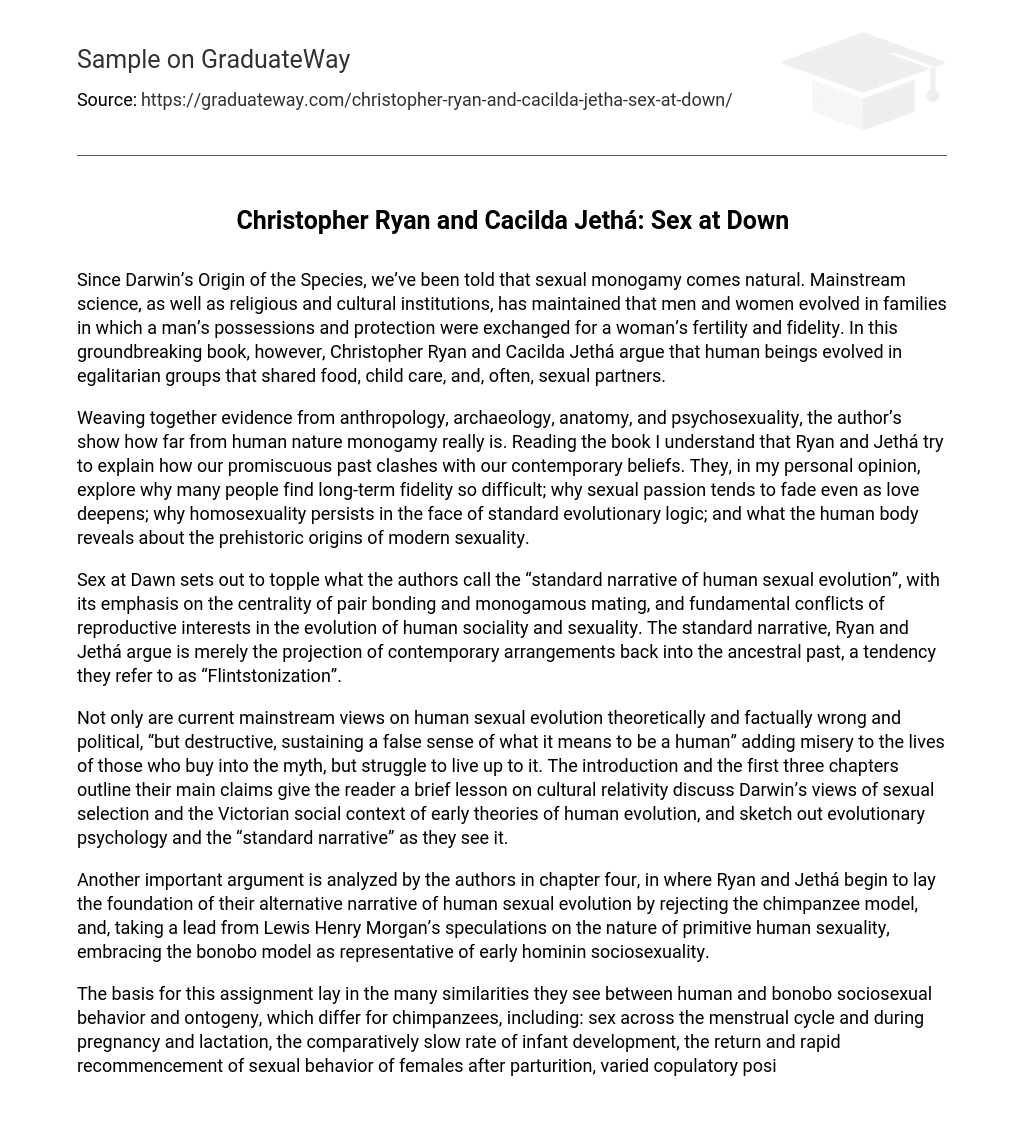Since Darwin’s Origin of the Species, we’ve been told that sexual monogamy comes natural. Mainstream science, as well as religious and cultural institutions, has maintained that men and women evolved in families in which a man’s possessions and protection were exchanged for a woman’s fertility and fidelity. In this groundbreaking book, however, Christopher Ryan and Cacilda Jethá argue that human beings evolved in egalitarian groups that shared food, child care, and, often, sexual partners.
Weaving together evidence from anthropology, archaeology, anatomy, and psychosexuality, the author’s show how far from human nature monogamy really is. Reading the book I understand that Ryan and Jethá try to explain how our promiscuous past clashes with our contemporary beliefs. They, in my personal opinion, explore why many people find long-term fidelity so difficult; why sexual passion tends to fade even as love deepens; why homosexuality persists in the face of standard evolutionary logic; and what the human body reveals about the prehistoric origins of modern sexuality.
Sex at Dawn sets out to topple what the authors call the “standard narrative of human sexual evolution”, with its emphasis on the centrality of pair bonding and monogamous mating, and fundamental conflicts of reproductive interests in the evolution of human sociality and sexuality. The standard narrative, Ryan and Jethá argue is merely the projection of contemporary arrangements back into the ancestral past, a tendency they refer to as “Flintstonization”.
Not only are current mainstream views on human sexual evolution theoretically and factually wrong and political, “but destructive, sustaining a false sense of what it means to be a human” adding misery to the lives of those who buy into the myth, but struggle to live up to it. The introduction and the first three chapters outline their main claims give the reader a brief lesson on cultural relativity discuss Darwin’s views of sexual selection and the Victorian social context of early theories of human evolution, and sketch out evolutionary psychology and the “standard narrative” as they see it.
Another important argument is analyzed by the authors in chapter four, in where Ryan and Jethá begin to lay the foundation of their alternative narrative of human sexual evolution by rejecting the chimpanzee model, and, taking a lead from Lewis Henry Morgan’s speculations on the nature of primitive human sexuality, embracing the bonobo model as representative of early hominin sociosexuality.
The basis for this assignment lay in the many similarities they see between human and bonobo sociosexual behavior and ontogeny, which differ for chimpanzees, including: sex across the menstrual cycle and during pregnancy and lactation, the comparatively slow rate of infant development, the return and rapid recommencement of sexual behavior of females after parturition, varied copulatory positions, food sharing associated with sexual activity, homo-and heterosexual activity, sex for non-reproductive ends, and possibly genital-genital rubbing.
In adopting the bonobo model of ancestral human socio-sexuality, Ryan and Jethá would seem to be placing promiscuous sexuality deep in the roots of human phylogeny. This, however, is complicated by the fact that before introducing the hypothesis of a bonobo-like ancestry, they assert that “a few million years ago, our ancient ancestors (Homo erectus) shifted from a gorilla-like mating system where an alpha male fought to win and maintain a harem of females to one in which most males had sexual access to females”.
Thus, according to the arguments put forth by Ryan and Jethá, any similarities between humans and bonobos are convergent adaptations to ecological pressures unspecified by the authors. I turn now to the next, and most important, aspect of Ryan and Jethá’s narrative: the nature of ancestral human sexuality. As mentioned above, the adoption of the bonobo model lays the foundation for their conception of ancestral mating as promiscuous and fluid, and males unconcerned with paternity.
Flowing from the bonobo model combined with the ethics of generosity and reciprocation described as vitally important to “fiercely egalitarian” modern foragers, is their hypothesis that “Socio-Erotic Exchanges (S. E. Ex. for short) strengthen the bonds among individuals in small-scale nomadic societies, forming a crucial, durable web of affection, affiliation, and mutual obligation”. In addition, they go on to note that “Without frequent S. E. Ex. it’s doubtful that foraging bands could have maintained social equilibrium and fecundity over the millennia”. Still working on the similarities and differences between humans and their ancestries, in Sex at Dawn we can find, for example, a very interesting discussion about human female orgasm, in where the authors of the book point out that female orgasmic behavior has been observed in some primate species with multimale- multifemale mating systems, whereas the monogamous gibbon female does not exhibit such behavior.
Following this, Symons’ (1979) by-product argument is summarized, and a few pages later, changes in vaginal acidity associated with orgasm are suggested as a possible mechanism of sire choice (pp. 266-267). In their discussion of the unique trait of perennially enlarged human female breasts, they favor some version of a fertility-signaling hypothesis, likening them to the sexual swellings of nonhuman primates. Human breasts, like bonobo sexual swellings, do not change much over the course of the ovulatory cycle (p. 261). Thus, the human breast is seen as evidence of a bonobo-like past.
The reading of this book has been really interesting and I think that the authors were really successful in making their points easy to understand and very solid. So, in my opinion, the beliefs about monogamy and polygamy that has been spread throughout our society since several centauries ago was based on a model that did not have reply on nature, and if accept the theories of evolutionism and Darwinism, the contrast between the behavior showed from our ancestors and ours should make us think about what went wrong during the different steps of our species ‘evolutions.





